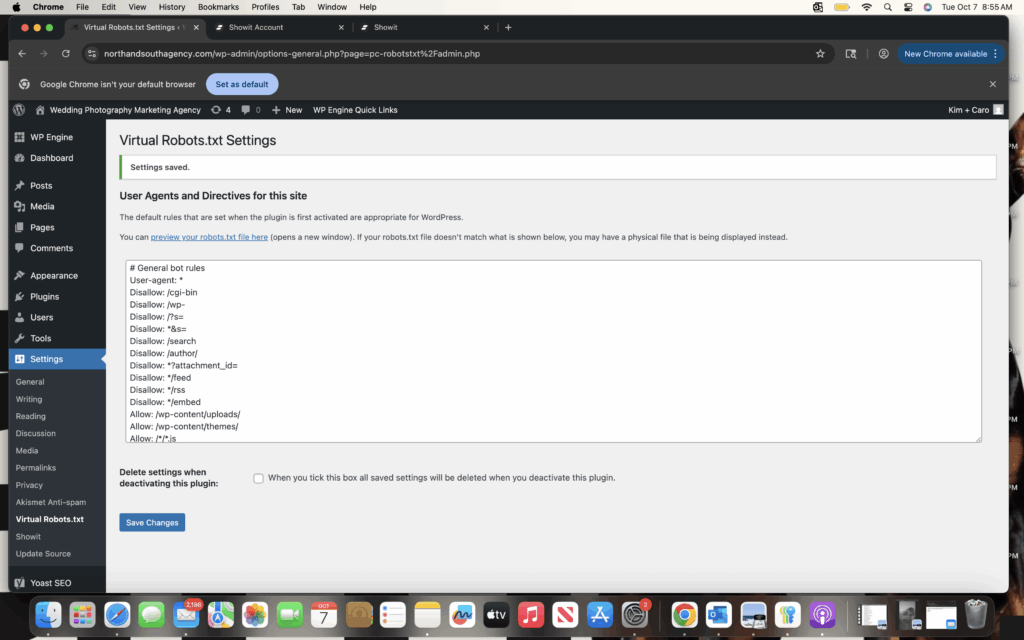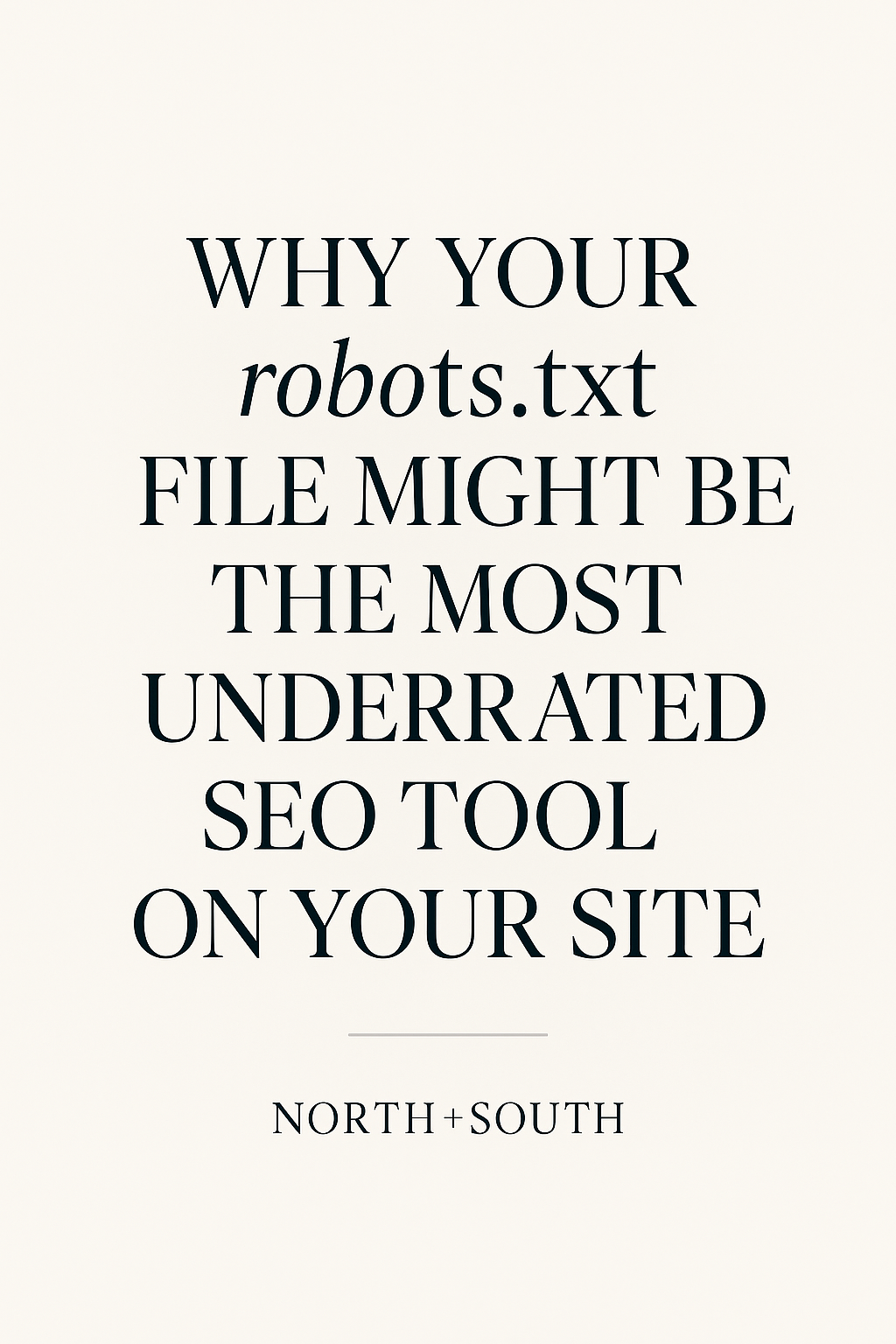Why Your robots.txt File Might Be the Most Underrated SEO Tool on Your Site
October 7, 2025
Most wedding pros spend hours designing a beautiful website but forget the small text file quietly sitting behind the scenes — your robots.txt.
This tiny file can completely change how your website performs in search results and how visible you are to AI engines like ChatGPT, Gemini, and Perplexity. In short, it’s the difference between your dream clients finding you effortlessly or never seeing your work at all.
What Is a robots.txt File?
A robots.txt file is a simple text document that lives at the root of your website (for example: https://yourwebsite.com/robots.txt). It’s one of the first things search engines look for when they crawl your site.
Think of it as a rulebook. It tells bots like Google, Bing, and now AI crawlers which pages they’re allowed to access, what to skip, and where to find your sitemap.
Here’s what a healthy setup looks like:
User-Agent: *
Disallow: /cgi-bin
Disallow: /wp-
Disallow: /?s=
Allow: /wp-content/uploads/
Sitemap: https://yourdomain.com/sitemap_index.xml
Each line has a purpose:
- User-Agent defines which bots can follow the rules.
- Disallow tells them what to skip.
- Allow tells them where to go.
- Sitemap gives them a roadmap of your entire site.
If you don’t have a robots.txt file, search engines will crawl your site blindly, wasting time on pages that don’t matter and potentially skipping the ones that do.

Why It Matters for Wedding Vendors
For creative entrepreneurs, visibility is everything. You want your galleries, blogs, and services to be seen by potential clients searching for wedding photographers, planners, florists, and venues.
A properly configured robots.txt file helps make that happen by:
- Guiding search engines to your most valuable pages
- Making sure your galleries and blog images are indexed correctly
- Preventing duplicate or behind-the-scenes content from being crawled
- Helping search engines understand your site structure and sitemap
When Google (and now AI crawlers) can easily read your sitemap, they can understand your business better — which means your brand gets surfaced more often in both search results and AI-powered recommendations.
Common Mistakes We See
At North+South, we review dozens of wedding vendor websites every month. You’d be surprised how often something as small as a misplaced line in the robots.txt file blocks your entire site from being found.
Here are the most common mistakes we catch:
- Using
Disallow: /(this blocks your entire website from search engines) - Forgetting the Sitemap line, which makes it harder for crawlers to index your pages
- Blocking
/wp-content/uploads/, which hides your photos from Google Images - Leaving an outdated Yoast or theme-generated block that duplicates or overrides your custom file
- Copy-pasting someone else’s robots.txt without adjusting it to your own domain
Even one small typo can mean your best blog post or gallery never shows up in Google — or worse, disappears entirely after a site redesign.
How to Optimize Your robots.txt for SEO + AI Visibility
Your robots.txt doesn’t have to be complicated. The key is to make it clear, minimal, and tailored to your business.
Here’s what we recommend:
- Keep the Yoast block at the bottom.
This ensures your sitemap link is properly connected to your SEO plugin. - Always allow access to your media folders.
Allow: /wp-content/uploads/This tells Google it can crawl and index your photo galleries. - Include your sitemap.
Sitemap: https://yourdomain.com/sitemap_index.xml - Avoid duplicate directives.
Some themes auto-generate extra blocks. Too many can confuse crawlers. - Test it.
Use the Google Search Console “robots.txt Tester” to confirm your setup. - Revisit it after every website update.
Plugins, rebrands, and migrations can reset your robots.txt without warning.
This small file might only take a few minutes to review, but it plays a massive role in how efficiently search engines understand your site.
The AI Visibility Connection
This is where things get exciting.
AI tools like ChatGPT, Gemini, and Perplexity now crawl websites just like Google does. That means your robots.txt file isn’t just about SEO anymore — it’s also about LEO (LLM Engine Optimization).
When your file is properly configured, AI engines can read your content, understand your expertise, and confidently reference your site in conversations.
If your robots.txt is blocking critical folders or missing a sitemap, those same AI crawlers might skip over you completely — even if your SEO is perfect.
In short, your robots.txt file has become one of the first signals AI models use to determine whether your brand deserves to show up in an AI-powered search.
What To Do Next
If you’re not sure whether your robots.txt file is helping or hurting your visibility, take these steps:
- Visit yourdomain.com/robots.txt and review the contents.
- Check that your sitemap link is accurate and up to date.
- Make sure your media folders are allowed.
- Test it inside Google Search Console.
- If you’re unsure, let our team take a look during your next AI Visibility Report.
Final Thoughts
It’s easy to overlook technical SEO, especially when you’re juggling content creation, client work, and daily business tasks. But this one small file can make or break how search engines and AI perceive your brand.
At North+South, we always say visibility is a team effort — between your strategy, your site structure, and your signals. Your robots.txt is one of those signals.
If you’ve been wondering why your website isn’t ranking or showing up in AI search results, start here. It might just be the missing piece.
Not sure if your robots.txt is helping your visibility?
Get your AI Visibility Report and see how search engines + AI models are reading your website.
Explore the report →
Or, let your AI Wedding Vendor Assistant handle the technical side for you — it’s trained to read + optimize your SEO files automatically.
Meet your assistant →

Q1: What is a robots.txt file?
A robots.txt file is a small text document that tells search engines and AI crawlers which pages or folders to access on your website and which ones to skip. It acts like a rulebook for how your site should be crawled, helping your most important content appear in search results.
Q2: Why does a robots.txt file matter for wedding vendors?
Wedding vendors rely on strong search visibility to attract clients. A properly set up robots.txt file helps search engines find your photo galleries, blog posts, and key service pages — while preventing duplicate or irrelevant pages from being indexed.
Q3: How can a robots.txt file impact SEO rankings?
It directly affects how efficiently Google crawls your site. When unnecessary pages are blocked and your sitemap is properly linked, Google can prioritize your best content. This can lead to faster indexing, stronger ranking signals, and better performance on both desktop and mobile search.
Q4: What are common robots.txt mistakes?
Some of the most common issues include accidentally blocking your entire site with Disallow: /, forgetting to include your sitemap link, or blocking your media folder (/wp-content/uploads/) — which hides your photo galleries from Google Images.
Q5: How does a robots.txt file affect AI visibility?
AI search tools like ChatGPT, Gemini, and Perplexity crawl the web similarly to Google. A clear robots.txt file signals to these AI models that your content is trustworthy and accessible, which increases your chances of being recommended or cited in AI-generated answers.
Q6: How can I check if my robots.txt file is working correctly?
Go to yourdomain.com/robots.txt and review the content. Then test it in Google Search Console’s robots.txt Tester to ensure your sitemap and media folders are accessible. If you’re unsure, your AI Visibility Report from North+South can analyze it for you.
Q7: What’s the best robots.txt format for WordPress users?
A clean, optimized version might look like this:
User-Agent: *
Disallow: /cgi-bin
Disallow: /?s=
Allow: /wp-content/uploads/
Sitemap: https://yourdomain.com/sitemap_index.xml
Keep it short, simple, and double-check it after every theme update or plugin change.
